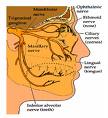
Trigeminal neuralgia (TN) , also known as tic douloureux, is considered by many to be among the most painful of conditions of mankind, and was once labeled the "suicide disease" because of the significant numbers of people taking their own lives before effective treatments were discovered. The disease entity of Trigeminal Neuralgia has been known now for centuries. It is probably one of the worst kinds of pains known to man. An estimated one in 15,000 people suffers from trigeminal neuralgia, although numbers may be significantly higher due to frequent misdiagnoses. Trigeminal neuralgia is relatively rare. An estimated 45,000 people in the United States and an estimated one million people worldwide suffer from trigeminal neuralgia. It usually develops after the age of 40 and affects women in a 2:1 ratio.
Trigeminal neuralgia results from a disorder of the trigeminal nerve and it is thought that TN results from irritation of the trigeminal nerve. This nerve supplies the face, teeth, mouth, and nasal cavity with feeling and also enables the mouth muscles to chew. The fifth cranial nerve gives sensation to almost the entire face, explaining why the disorder can cause pain in different areas of the face. Trigeminal neuralgia is the most frequent of all neuralgias.
People with trigeminal neuralgia become plagued by intermittent severe pain that interferes with common daily activities such as eating and sleep. They live in fear of unpredictable painful attacks. It is an acute, piercing, electric shock-like pain in those regions of the face served by the Trigeminal (5th) Cranial Nerve (CN V) . CN V serves three areas of the face; the forehead and eye, the cheek, and the jaw. Although trigeminal neuralgia cannot always be cured, there are treatments available to alleviate the excruciating pain. Historically anti convulsive medications were normally the first treatment choice, such as Tegretol or Neurontin. In trigeminal neuralgia, painful attacks may occur frequently over the course of a few hours to several weeks at a time, and then diminish for a period of weeks or months. Each attack can last from a few seconds to up to 2 minutes. It may go into remission or stop completely for months or years.
Due to trial and error use of medications the pain may be best controlled by the use of interferential stimulation, IFT, since the treatment can be rendered prior to the onset of the pain. With the portablility of the Infrex Plus unit the patient can treat as needed whereever the patient is. The IFT brings immediate sensory relief and prevents pain or reduces the severity of the pain. Due to the face having less moisture because of the tissue types the interferential treatment may be best when used in conjunction with moist packs to allow greater penetration of the interferential current to block the pain to the brain. The elimination of the first primary attacks by interferential therapy can prevent the reoccurence of future attacks.
Unlike drugs, the interferential treatment efficacy is immediate for the patient. Upon beginning treatment the relief is instant and can be long lasting due to the physiological changes caused by the interferential treatment itself. It is not uncommon for one 30 minute treatment of interferential to be sufficient to stop any recurrences of pain for months. With prolonged frequency of use, when needed, the trigeminal neuralgia may potentially be effectively eliminated and the patient remains free of the disease.


